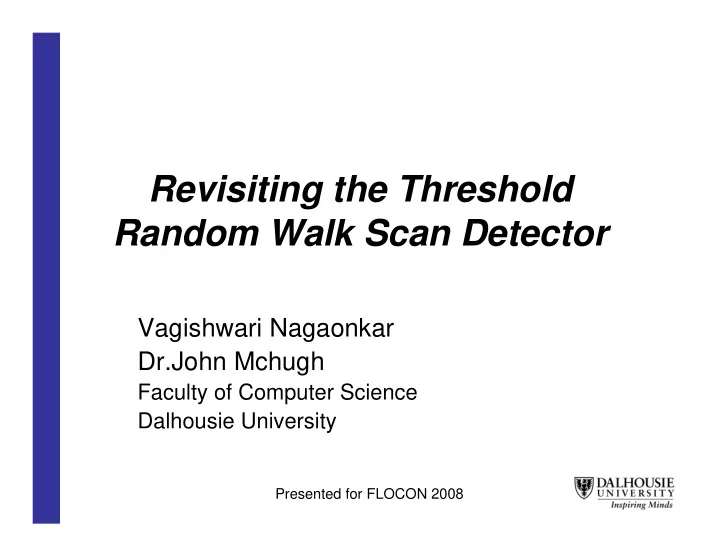

Revisiting the Threshold Random Walk Scan Detector Vagishwari Nagaonkar Dr.John Mchugh Faculty of Computer Science Dalhousie University Presented for FLOCON 2008
Introduction • Initial Activity in many intrusions – Scanning • Techniques to detect these initial scans • One of the effective algorithms – Threshold Random Walk
Introduction (contd.) • Challenges when using TRW – UDP and ICMP Traffic – Repetitive Scanning – Slow and Stealthy Scans • Using Bloom filters – eliminate repetitive input to TRW – look for reverse matches in time ordered data
Threshold Random Walk • Scan Detection Algorithm based on sequential hypothesis testing. • Uses a positive reward based scan detection. – For a given host, records connection attempt Scanner made : Connection Ratio Threshold Ratio Can’t Say Successful Decreases Failed Increases Benign Time
Threshold Random Walk • The ratio is calculated as : • Where the probabilities are : – Y = success (0) or failed (1) connection attempt – H0 = benign hypothesis – H1 = scanner hypothesis Θ 0 = probability that the source is benign, for a successful connection – attempt Θ 1 = probability that the source is scanner for a successful – connection attempt
Threshold Random Walk • The thresholds are calculated based on – desired true positive ( β = 0.99) – desired false positive ( α = 0.01)
Bloom Filter • It’s a Data Structure – test the membership of an element for a given set • Definition of the Structure – bit array of m bits – k different hash functions – Hash functions maps a key value to one of the m array positions.
Bloom Filter • Properties : – False positives possible – No false negatives – Elements can be added – No deletion possible – Greater the number of elements, higher the probability of false positives. – Space Efficient – Cannot determine the elements present in it.
Modified TRW with Bloom Filter • TRW hit or miss definition – For a given pair in the flow record eg {sip, dip} • HIT = if a corresponding entry {dip, sip, sport, dport, proto} is found within a specified timeout period • MISS = if a corresponding entry {dip, sip, sport, dport, proto} is not found within a specified timeout period
Modified TRW with Bloom Filter • Bloom Filter uses 10 hash functions and a bit vector of size 2^32 • Experiment Set up : – Pass the flow records through the bloom filter. – Specify selection criteria: {sip, dip}, {sip, dip, proto}, {sip, dip, sport}, {sip, dip, dport}, {sip, dip, sport, dport, proto} – Use the TRW scanning algorithm.
Modified TRW with Bloom Filter Specify Unique Criteria: SP or SDP or SDSP or SDDP or SDSDP Flow Unique Records Entries Bloom Modified Filter TRW
The Dataset • A year long trace collected on a /22 enterprise network • Using Silk Tools • Internal Network Hosts – Total Address Space = 1024 – #Active hosts in a given day = varies between 60-70 – Active Address Space ~ 6%
The Dataset OutIps Seen Non Responsive EtoO OtoE % Non Responsive Out ips Out ips Feb 26680 7270 19410 72.75112444 Mar 30232 3866 26366 87.21222546 Apr 56126 14576 41550 74.02986138 May 2355612 106893 2248719 95.46219836 June 2847371 283270 2564101 90.05152472 July 2601834 246312 2355522 90.53313932 Aug 30181 29097 1084 3.591663629 Sept 126913 126549 364 0.28681065 Oct 330740 277438 53302 16.11598234 Nov 4050 2932 1118 27.60493827 Dec 2226535 254484 1972051 88.57040199 Total 10636274 1352687 9283587 87.28232274
The Dataset
The Dataset
Problems faced during Analysis • Time granularity – millisecond not available. – The order of flow records for the same second is the outside to inside put first. • Background noise in the traffic. • ICMP ping traffic causes false detection.
Problems faced during Analysis
Preliminary Results • TRW Parameters used: – Theta1 determined based on the %active internal hosts compared to the total address space ~ 0.0654 – Theta0 ~ 0.8 • Changed theta0 for benign hosts to hits / (hits + miss) • The value of new theta0 ranged from 0.45 to 1.00 • All benign hosts still classified as benign – Alpha (desired false positive) = 0.01 – Beta (desired true positive) = 0.99
Preliminary Results Flows per Month Number of Flows 40000000 Original 35000000 Number of Flows Number of Flows SD 30000000 25000000 20000000 Number of Flows 15000000 SDP 10000000 Number of Flows 5000000 SDSP 0 June March July Number of Flows April May Sept Oct Dec SDDP Number of Flows Month SDSDP
Preliminary Results Scanner Detected With TRW 50000 Number of Scanners 40000 With TRW + Bloom SD 30000 With TRW + Bloom 20000 SDP 10000 With TRW + Bloom SDSP 0 With TRW + Bloom h e l y t c y t i p r c n l e c a u p e O u r D M J a A S SDDP J M With TRW + Bloom Month SDSDP
Preliminary Results Plot of Likelihood ration for Scanners
Preliminary Results Plot of Likelihood ration for Can’t Says
Preliminary Results Plot of Likelihood ration for Benign
Initial Conclusions • Using Bloom filter, reduces the false positives, ( by how much ? ) – unique entries considered for a given filter criteria • Using specific filter criteria for the bloom filter – detects vertical scanning – detects horizontal scanning
Further Work In Progress • Need to improve the technique by – Vary theta0 and theta1 values – Effect of timeout period – Real time scenario • Long term analysis of IPs toggling between the three regions – Esp. from scanning to Can’t say or benign
Acknowledgments • Ron McLeod • TARA • Faculty of Computer Science, Dalhousie University
Thank you Questions ?
Recommend
More recommend